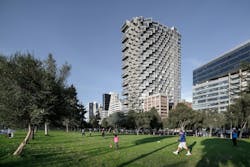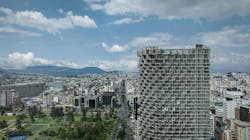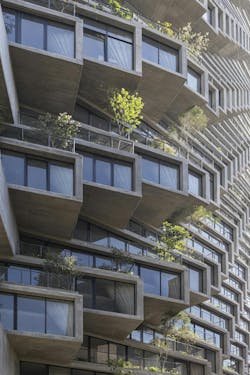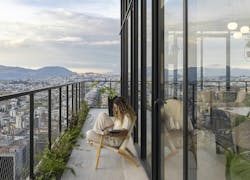Bjarke Ingels’ first design project in South America is poised to open next year in Ecuador
By John Caulfield, Senior Editor
In 2013, Quito, Ecuador’s capital, opened its new airport, which had been relocated from the metro’s center to an agricultural site 12 miles northeast of the city. Since then, Quito’s skyline, which before that move had been a dense array of mostly low-rise buildings, has been reshaped by new, vertical structures that include the 24-story tower QORNER, designed as a “hillside of terraces” by Sadfie Architects and opened in 2020; and the 24-story mixed-use EPIQ Residences, designed in the shape of a quarter circle by Bjarke Ingels Group (BIG), and scheduled to open in 2023.
Uribe Schwarzkopf was the developer on both projects. That firm also hired BIG in 2017 to design IQON, a 390,000-sf mixed use building with 215 apartments, commercial units, office space, and various amenities. IQON, BIG’s first project in South America, rises 427 feet, which will make it Quito’s tallest building when it opens next year.
These towers “represent the ongoing transformation of Quito into a cornerstone of architecture, design, and innovation,” states Tommy Schwarzkopf, Uribe Schwarzkopf’s co-founder.
IQON is positioned as an extension to the 165.5-acre La Carolina Park. The building features a notable curved corner, wrapped by terraces that continue around the building’s perimeter with views of the park, city, and the Pichincha volcano.
Individual “pixels” are stacked 32 floors high and rotated to provide the best possible views while simultaneously creating terraces for the apartments. “Each apartment floor features through-units—apartments that have terraces on both the north and south facades—which not only allow for views across the entire city, but also offer the opportunity for cross ventilation and a sense of openness,” explains Thomas Christoffersen, a Partner at BIG.
Bjarke Ingels Group's high-rise design highlights Ecuador’s biodiversity
The building integrates greenery wherever possible to take advantage of Ecuador’s temperate climate and ecology. (The country reputably has the most plant species per square meter in the world.) Quito’s biophilia is carried from the public spaces below into the private domain of each home via the sculptural planters that are integrated into the architecture of the building. The planters become a unique concrete sculpture inside the apartments, while transforming the façade of the building into an exclamation of the city’s verdant biodiversity.
Once the vegetation planted on the terraces outgrows the planter, it can be replanted in parks all over the city.
The building’s ground floor plaza includes public spaces, retail units, and public art. It also provides a pathway that connects the park to the rest of the neighborhood. Upon entering the lobby, the material palette transitions from the raw, pared-back exterior to a more refined aesthetic: marble stone pavers complement the custom millwork reception desk, and concrete touch points nod to the façade. Deep emerald-green tones are utilized on the ceiling tiles, mailboxes, and through to the elevator lobby, located beyond a blackened-steel portal.
Other amenities include an integrated lap pool and terraces at the top of the building, a gym and squash court, a spa, a bowling alley, entertainment rooms, and a business center. IQON is the first mixed-use building in Quito to have a preliminary EDGE certification, granted by GBCI (Green Business Certification Inc.) and IFC (International Finance Corporation).
Joining BIG and Uribe Schwarzkopf on IQON’s building team were the structural engineers Rene Lagos Engineers and Fernando Romo, the wind consultant CCP Wind Tunnel, the civil consultant Geo Estudios, mechanical consultant Trialmech, plumbing consultant Incoayam, and electrical consultant Consel.



